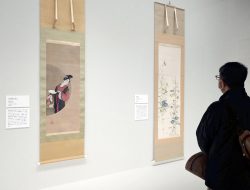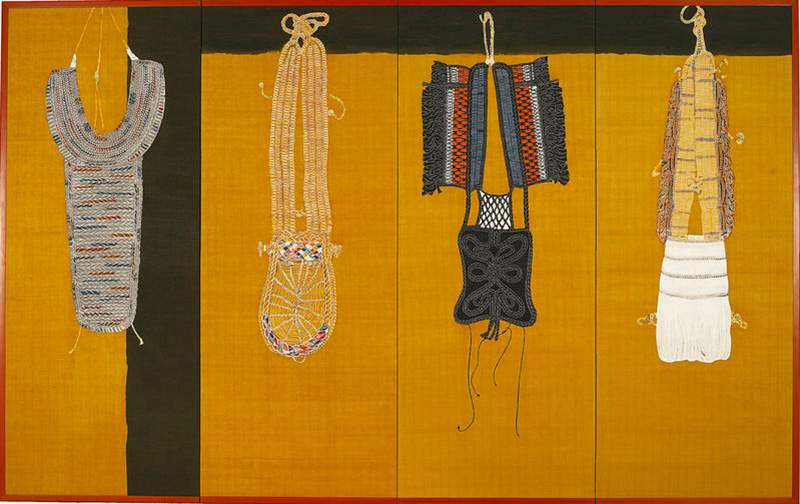
“Bandori-zu Yonkyoku Byobu” (Four-fold screen with bandori design) by Keisuke Serizawa. The piece is an unusually realistic work for Serizawa, who is known for bold designs in bright colors.
12:48 JST, January 13, 2022
Folding screens are typically adorned with elegant designs based on traditional themes of natural beauty in Japanese aesthetics, such as flowering trees and a moonlit sky. Screens certainly did not portray something as simple as straw handicrafts common folk used in their everyday lives.
That’s why master dye artist Keisuke Serizawa surprised everyone when he created “Bandori-zu Yonkyoku Byobu” (Four-fold screen with bandori design), a folding screen depicting straw backpack supports hanging from a thick black beam.
Such backpack supports are called bandori in the Shonai area in Yamagata Prefecture, and they help protect the shoulders and lower back when carrying a heavy load.
Serizawa’s depiction of them conveys the power and strength of tools made for and used in everyday life.
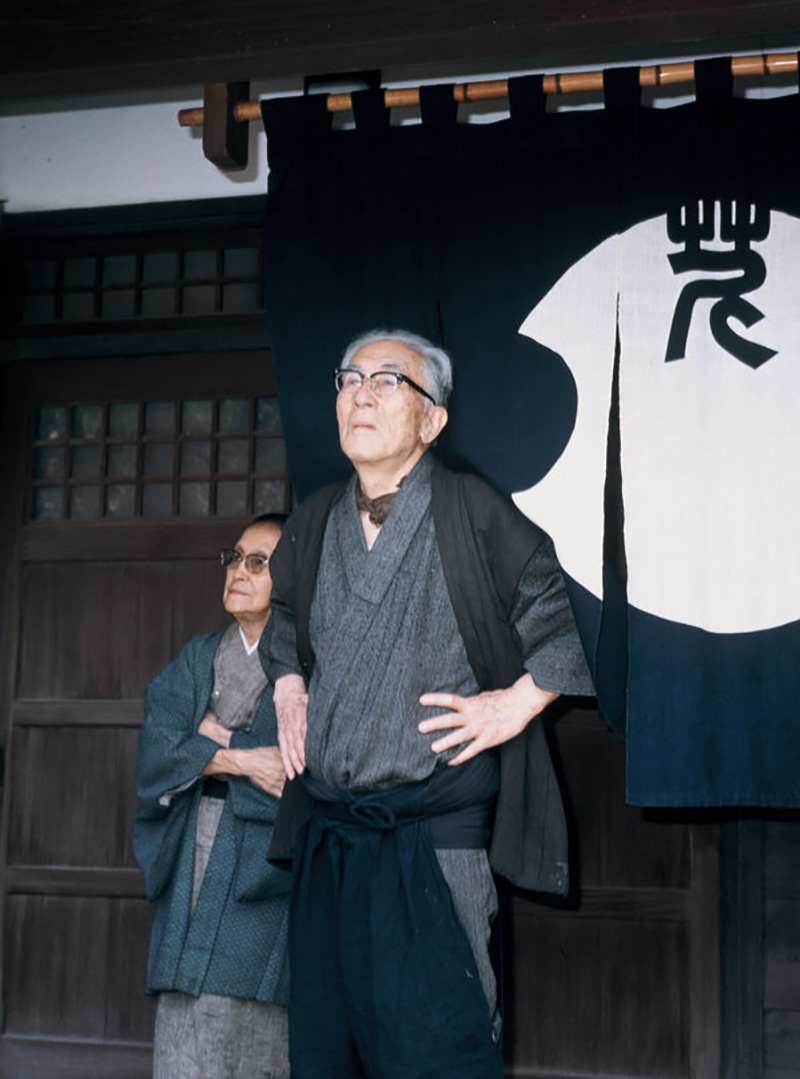
Keisuke Serizawa at the age of 81 in front of his atelier with his wife Tayo in Kamata, Tokyo, in 1976
Serizawa created the work, measuring 155.6 centimeters by 247.2 centimeters, in 1957. He used stencil paper with patterns and a resist paste to dye the bandori design on silk cloth.
“The texture and knitted stitches of bandori are realistically expressed with his katazome stencil dyeing technique,” said Seiichiro Shiratori, the director of the Shizuoka City Serizawa Keisuke Art Museum, which owns the artwork. “The beauty of the sculpted shapes of straw crafts is conspicuous in this work.”
Straw backpack supports were utilized in farming villages in the Tohoku and Hokuriku regions. The distinctive name was used in areas along the Sea of Japan in Yamagata Prefecture. It is said that the term bandori stems from their unique shape that looks like musasabi, or giant flying squirrel, spreading itself out to glide through the air. Such squirrels are also called bandori. Colorful and ornate bandori were used when transporting a bride’s trousseau to her new home.
Hailing from Shizuoka Prefecture, Serizawa (1895-1984) sympathized with the mingei folk craft movement, which placed value on ordinary craftspeople making everyday tools. The movement was started by Muneyoshi Yanagi (1889-1961), a prominent thinker of the time. Serizawa joined Yanagi’s trips to rural areas across Japan to examine local handicrafts and discovered their simple beauty.
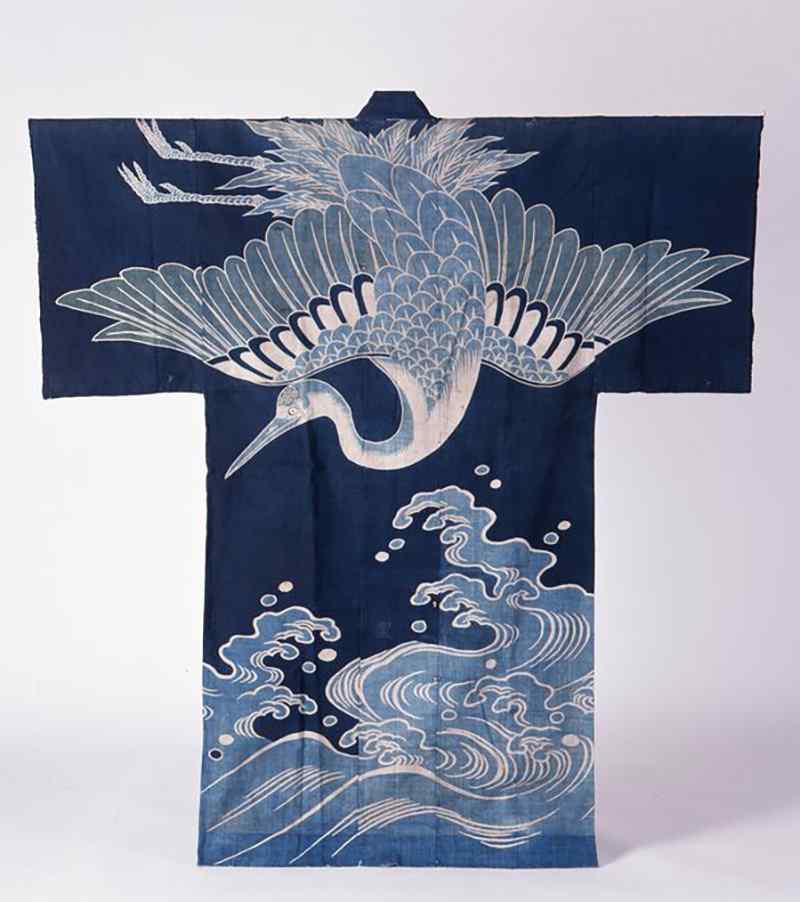
“Nami ni Tsurumon Yogi” (Sleeping garment with wave and crane patterns) from Serizawa’s collection. He is also known as a collector of handicrafts. The piece is currently on display at an exhibition titled “Japan Blue: Ai no Aru Kurashi” (Life with indigo dyeing) at Shizuoka City Serizawa Keisuke Art Museum.
The Japan Folk Crafts Museum in Tokyo, whose first director was Yanagi, has a large collection of straw crafts in addition to ceramics and dyed and woven fabric items that have been collected since before World War II.
The collection includes a pair of tightly knitted traditional Japanese snow boots made of straw and magnificent straw raincoats, which must have been made with great care by snowbound farmers in the off-season.
“Many of these items might have been abandoned and forgotten if Yanagi and his followers had not recognized their value,” said Takashi Sugiyama, chief curator at the folk crafts museum.
In Yanagi’s time, the making of handicrafts in farming villages was already on the decline, and he advocated for handing down the skills and techniques to make the crafts.

Eiichi Saito, left, works with his granddaughter Yuri in Tsuruoka, Yamagata Prefecture, making bandori, seen on the floor.
During the war, Serizawa led the creation of new handicrafts using wild cherry trees in Akita Prefecture and straw in Yamagata Prefecture.
“I tried to make handicrafts that also appealed to people in urban areas,” Serizawa said.
Yanagi believed the Tohoku region was a treasure trove of folk crafts. After the war, he wrote a book titled “Teshigoto no Nihon” (Japanese handicrafts) and held up bandori as “representative of farmers’ crafts.”
Serizawa drew illustrations of handicrafts from various places for the book, which contributed to increasing public awareness of the value of folk crafts.
Serizawa created the bandori folding screen during Japan’s period of high economic growth.
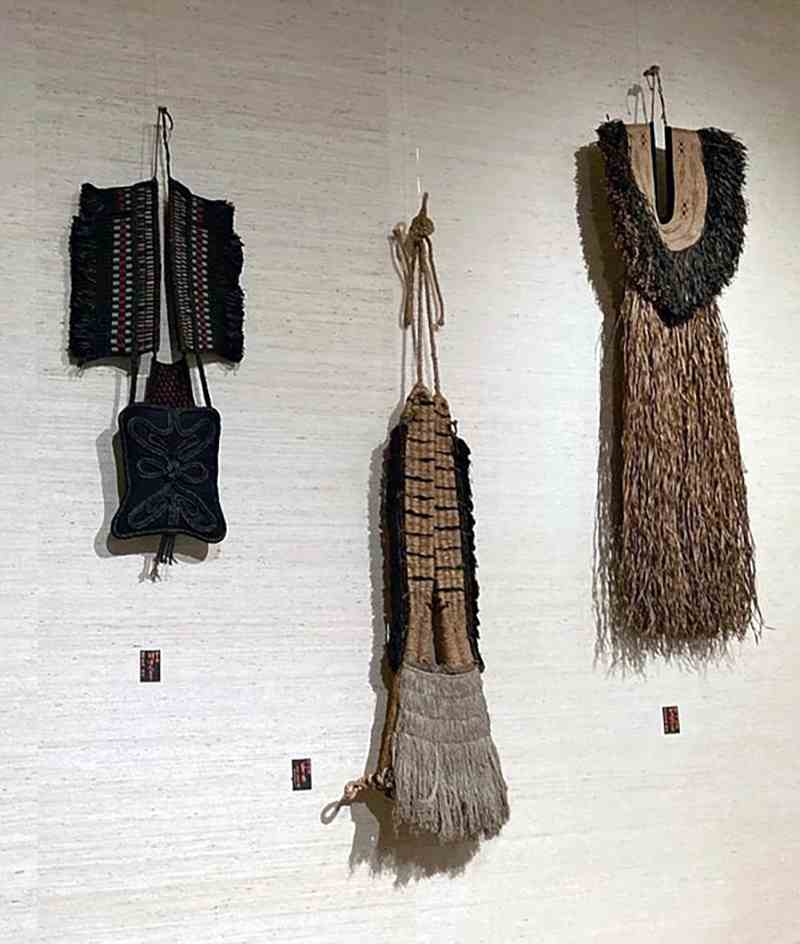
Two bandori and a straw raincoat, right, that were made around the 1930s were on display at The Japan Folk Crafts Museum until November.
“Straw crafts in particular are greatly affected by lifestyle changes. They’re also difficult to preserve,” Shiratori said. “From this artwork, I feel Serizawa’s respect and sorrow for disappearing handicrafts, techniques and craftspeople.”
Nevertheless, Yanagi and Serizawa’s ambitions live on in Tohoku.
In Tsuruoka, Yamagata Prefecture, a local group holds workshops and other events to preserve and hand down the techniques and culture of straw crafts.
Eiichi Saito, 87, a local craftman specializing in straw, teaches workshops. Saito has been making straw sandals since he was a child. In recent years, he has been receiving orders, mainly from shrines to make shimenawa sacred straw ropes, because he is one of the few people who possesses the skills indispensable for making them.
To Saito’s pleasant surprise, in the spring of 2020, his granddaughter Yuri, 30, started helping him as a side job. She quickly learned from Saito and is now able to make bandori. Yuri said, “I felt my grandfather’s skills are so precious that I should not let them disappear.”
"Culture" POPULAR ARTICLE
-

Van Cleef & Arpels Dazzles with Art Deco Artisanry at Tokyo Exhibit
-

Disney’s ‘Twisted-Wonderland’ Animated Series Puts Villains in Spotlight: New Show Features School Inspired by Classic Disney Films
-

Ayumi Hamasaki’s Shanghai Concert Canceled Day Before Schedule as Part of Beijing Backlash
-

‘The World Masterpiece Theater Series’ Celebrates 50 Years; Animator Looks Back on Creating Anime Classics
-

Popularity of Piggy Banks Across Time and Place Seen at Bank’s Museum of Money Boxes in Hyogo Pref.
JN ACCESS RANKING
-

Tokyo Economic Security Forum to Hold Inaugural Meeting Amid Tense Global Environment
-

Keidanren Chairman Yoshinobu Tsutsui Visits Kashiwazaki-Kariwa Nuclear Power Plant; Inspects New Emergency Safety System
-

Imports of Rare Earths from China Facing Delays, May Be Caused by Deterioration of Japan-China Relations
-

University of Tokyo Professor Discusses Japanese Economic Security in Interview Ahead of Forum
-

Japan Pulls out of Vietnam Nuclear Project, Complicating Hanoi’s Power Plans




